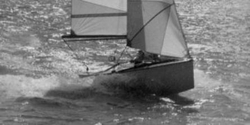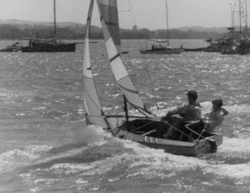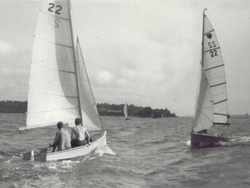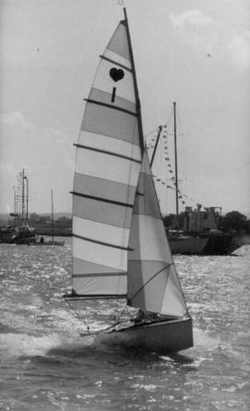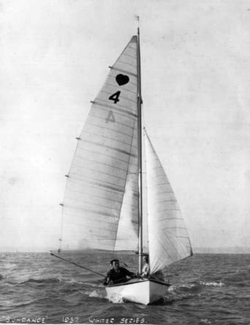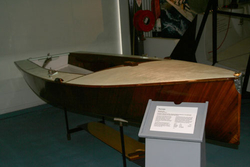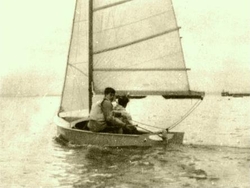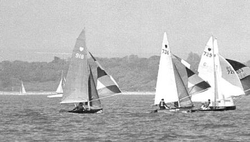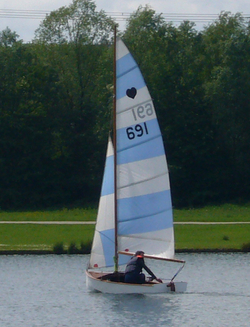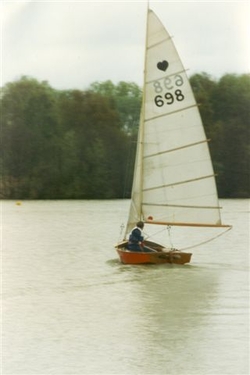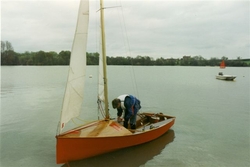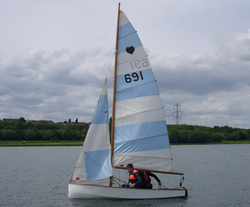The Beginning 1950's and 1960's
There's a nice tale about how the class came about. The story is that back in 1951 John Spencer designed a 12 foot cruising dinghy for Ray Early to sail round the Auckland Area in New Zealand. When asked what their new boat was, his wife said “I don't know, but she's a perfect little cherub to Sail”. It seems, however, that this is a “nautical myth”, and according to John Spencer the first boat was built to race in the “Pennant” restricted class and was to be named Cherub even before launching. A 1952 article from seaspray magazine describes how it all began.
The Cherub was the first significant design from John Spencer, and many would put it as the starting point of the whole Antipodean Sailing boom. The Cherub grew very fast in New Zealand in the 50s, about 450 boats in the first 8 years - and remember New Zealand is a small country with a population of about one fifteenth of that of Great Britain. This was mainly due to what was effectively a partnership between Sea Spray magazine and John Spencer. Sea Spray allowed Spencer almost as much space as he wanted to provide publicity and `how to' construction articles. In fact for a time Sea Spray was the official Cherub HQ, keeping the sail number register, and being the central point for all correspondence from the town associations.
This was all in spite of a certain amount of opposition from the NZ National authority, who were committed to promoting the older (and heavier) National classes, Z, IA and X class. They actively discouraged the Cherubs and had it not been for Sea Spray magazine becoming an active John Spencer promoter, the Cherub could well have disappeared without trace.
From New Zealand the class was introduced to the UK in 1956 when Spencer Mk 2s were built - as a one design - by McCutcheon's of Cowes. At first the class spread around the Solent, with Portsmouth being another early stronghold. By 1963 the class had reverted to being a restricted develepment class, as recounted by Martin Jolliffe.
The first Cherub arrived in Australia in around 1958, when New Zealander Frank Bethwaite, emigrating to Australia, took Cherub 47 with him, and sailed with his wife in Sydney Harbour. It doesn't seem that any other boats were built then, nor did he attempt to found a class. The Cherub as a class in Australia started at Mounts Bay YC, Western Australia in 1960/1. Basil Wright and a number of friends built around half a dozen Cherubs, probably Spencer mk6s, as junior trainers, sailed initially 3-handed by their 14year old kids, and then as two handers as the youngsters got bigger. It initially spread to Victoria and Queensland and perhaps only a little later to Sydney, when, aongst others, the growing Bethwaite family got involved with the class.
Early UK Cherubs had appreciably less sail area than modern ones, with stated dimensions of 62 sq.ft. for the mainsail, 27sq. ft for the jib, and 60sq.ft spinnaker. The spinnaker was particularly unusual, since it was typically a virtually flat triangular sail, which could be carried with the true wind forward of the beam. This sail, set from a spinnaker pole that could be 9 ft long, resulted in spectacular close reaching performance, but was rather less effective on a run. In the early days these spinnakers were quite often cut as single luff sails - asymmetric spinnakers!
The Cherub was a considerable influence on other classes. The 14ft NZ Javelin was virtually a straight enlargement of the Cherub. Frank Bethwaite's first prototype for the NS14 was a drawn out Cherub, although they later elected to use a Spencer Javelin hull design for the first boats. From NS14 development came the Tasar, the Bethwaite skiffs and the 49er.
In the early 60s Cherub design in the UK was very much in the mainstream of Northern hemisphere dinghy design at that period. A UK Cherub hull of that era tends to look pretty much like a baby Scorpion. In the late 60s the first of many infusions of antipodean ideas occurred. John Spencer's mk7 design was introduced into the UK, which had a wider and flatter hull shape, and planed appreciably faster.
The theme in design through the next few years was beam. The only restriction on beam was that the boat should be no more than 5 feet at mid length, and boats of this era flared out a great deal after that. One result of this was that if the boat was allowed to heel a lot the poor crew was left attempting to stand on a gunwale that was sloping steeply towards the bow. Large and solid foot stops to brace the front foot against were a common feature! At least two UK boats had a maximum beam in excess of 6 feet, giving something close to Merlin-Rocket proportions.
The Cherub Class International Association was formed in 1967 with membership comprising the New Zealand Australian & UK Associations.
